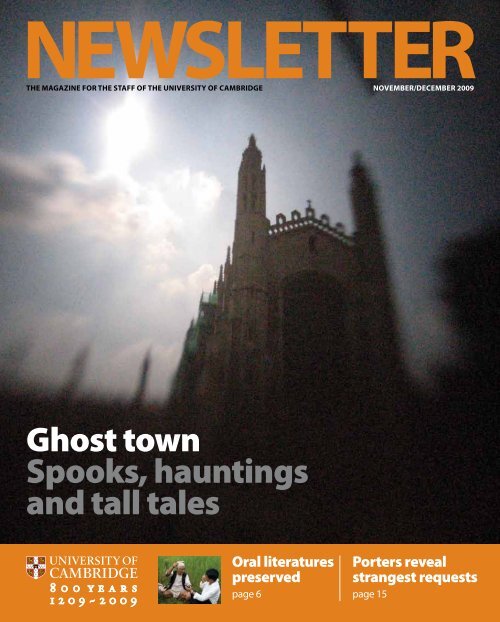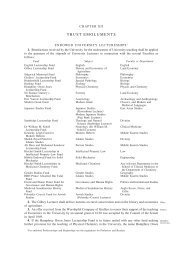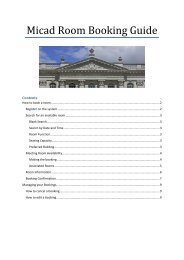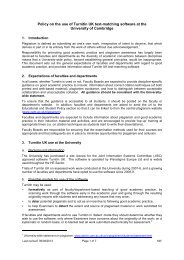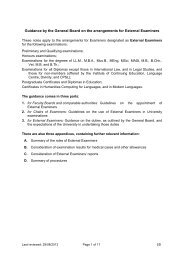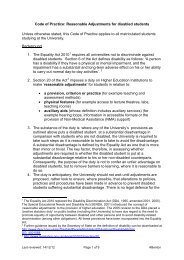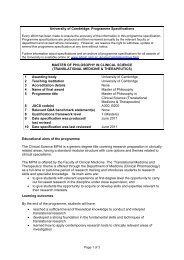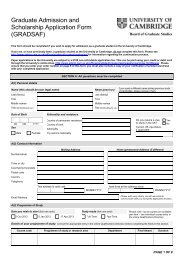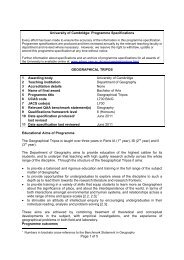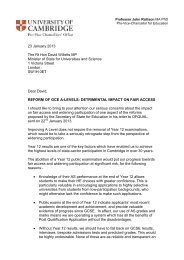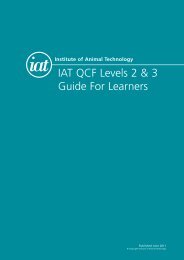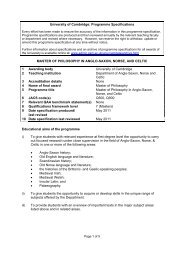Ghost town Spooks, hauntings and tall tales - the University Offices ...
Ghost town Spooks, hauntings and tall tales - the University Offices ...
Ghost town Spooks, hauntings and tall tales - the University Offices ...
You also want an ePaper? Increase the reach of your titles
YUMPU automatically turns print PDFs into web optimized ePapers that Google loves.
The magazine for The sTaff of The UniversiTy of Cambridge november/deCember 2009<br />
<strong>Ghost</strong> <strong>town</strong><br />
<strong>Spooks</strong>, <strong>hauntings</strong><br />
<strong>and</strong> <strong>tall</strong> <strong>tales</strong><br />
Oral literatures<br />
preserved<br />
page 6<br />
Porters reveal<br />
strangest requests<br />
page 15
SnaPShOt<br />
good enough to eat: One of <strong>the</strong> more<br />
unusual gifts to mark <strong>the</strong> <strong>University</strong>’s<br />
800th anniversary was presented to Vice-<br />
Chancellor Professor Alison Richard at a<br />
reception at <strong>the</strong> Fitzwilliam Museum.<br />
A large-scale sculpture of <strong>the</strong> building<br />
was created by award-winning pastry<br />
chef Thomas Lui as <strong>the</strong> centrepiece<br />
of a gala dinner held in Hong Kong<br />
last month. It was <strong>the</strong>n flown over to<br />
Cambridge. What was unusual about <strong>the</strong><br />
sculpture? It was made entirely of white<br />
chocolate.<br />
Wheel good fun: Three teams of staff<br />
rode from Oxford to Cambridge in<br />
September in support of three different<br />
charities <strong>and</strong> <strong>the</strong> <strong>University</strong>’s 800th<br />
anniversary. The sixth annual Oxford to<br />
Cambridge bike ride was organised by<br />
<strong>the</strong> British Heart Foundation. Each staff<br />
team covered <strong>the</strong> 89 miles on <strong>University</strong><br />
Messenger Bicycles. The teams rode in<br />
support of three charities: <strong>the</strong> British<br />
Heart Foundation, Talk to Stars <strong>and</strong><br />
Camfed, <strong>the</strong> <strong>University</strong>’s Charity of<br />
<strong>the</strong> Year.<br />
Tomorrow’s world: More than 60<br />
innovations went on show at <strong>the</strong> Open<br />
House Festival of Interactive Technology<br />
in September. The festival was organised<br />
by <strong>the</strong> <strong>University</strong> <strong>and</strong> Microsoft Research<br />
Cambridge to mark <strong>the</strong> <strong>University</strong>’s<br />
800th anniversary. It offered a preview of<br />
interactive displays, games <strong>and</strong> computer<br />
technologies, among <strong>the</strong>m this ‘wearable<br />
impairment simulator’, which helps<br />
designers underst<strong>and</strong> how capability<br />
loss affects people’s ability to perform<br />
everyday activities.<br />
Choir auditions: Do you or your friends<br />
have a musically talented six or sevenyear-old<br />
son? If so <strong>the</strong> King’s Choir would<br />
like to hear from you. The college is<br />
recruiting new choristers, with auditions<br />
set for 16 January 2010. Successful boys<br />
will be educated at King’s College School<br />
<strong>and</strong> will receive a musical training of <strong>the</strong><br />
highest order. Fees are subsidised <strong>and</strong> a<br />
range of financial support is available.<br />
To register an interest email choir@kings.<br />
cam.ac.uk.<br />
2 | november/deCember 2009 | UNIVERSITY OF CAMBRIDGE NEwSlETTER<br />
PHILIP MYNOTT<br />
cOntentS<br />
Cover Take a walk on<br />
<strong>the</strong> dark side with our<br />
round-up of <strong>the</strong> spookiest<br />
Cambridge ghost stories.<br />
Turn to page 8.<br />
3-4 What’s new<br />
5 Tribute<br />
Professor Sir David Williams remembered<br />
6-7 making a difference<br />
The fight to preserve oral literatures<br />
8-10 inside <strong>the</strong> colleges<br />
11 Know your <strong>University</strong><br />
A brief guide to <strong>the</strong> Whipple Museum of<br />
<strong>the</strong> History of Science<br />
12 People<br />
13 Prizes, awards <strong>and</strong> honours<br />
14 advertisements<br />
15 behind <strong>the</strong> scenes<br />
Unusual requests put to porters<br />
16 back page<br />
newSletter<br />
The Newsletter is published for <strong>the</strong> staff of <strong>the</strong><br />
<strong>University</strong> of Cambridge <strong>and</strong> is produced by <strong>the</strong><br />
Office of External Affairs <strong>and</strong> Communications.<br />
Please send in ideas for <strong>the</strong> content <strong>and</strong> o<strong>the</strong>r<br />
ways we can improve <strong>the</strong> publication.<br />
Tel: (3)32300 or email newsletter@admin.cam.ac.uk.<br />
Suggestions for articles for <strong>the</strong> February/March<br />
edition should reach <strong>the</strong> Editor by 4 December.<br />
Editor: Andrew Aldridge<br />
Advertising: Nick Saffell<br />
Design: Creative Warehouse<br />
Printers: Labute Printers<br />
<strong>Ghost</strong> <strong>town</strong><br />
<strong>Spooks</strong>, <strong>hauntings</strong><br />
<strong>and</strong> <strong>tall</strong> <strong>tales</strong><br />
newSletter Online<br />
www.admin.cam.ac.uk/univ/newsletter<br />
The magazine for The sTaff of The UniversiTy of Cambridge november/deCember 2009<br />
Oral literatures Porters reveal<br />
preserved strangest requests<br />
page 6<br />
page 15<br />
COVER IMAgE: ISSAM KOURBAJ
MARIE SADLER<br />
what’S new<br />
Your comments <strong>and</strong> contributions are always welcome.<br />
Please send <strong>the</strong>m to <strong>the</strong> Editor at newsletter@admin.cam.ac.uk<br />
The deadline for <strong>the</strong> next issue is 4 december.<br />
Sainsbury laboratory passes milestone<br />
AN IMPORTANT MILESTONE in <strong>the</strong><br />
creation of a new world-class research<br />
facility was marked last month with a<br />
topping out ceremony.<br />
The Sainsbury Laboratory, set to<br />
house 120 scientists studying plant<br />
development, is a £92 million facility<br />
currently under construction. The<br />
topping out ceremony traditionally<br />
marks <strong>the</strong> completion of <strong>the</strong> outer<br />
structure of a new building.<br />
Nearly 100 guests ga<strong>the</strong>red at <strong>the</strong><br />
site to hear speeches from Roy Murphy,<br />
Managing Director of main contractor<br />
Kier, Professor Ian Leslie, Pro-Vice-<br />
Chancellor for Research, Professor<br />
John Parker, Director of <strong>the</strong> Botanic<br />
garden, where <strong>the</strong> building is sited,<br />
<strong>and</strong> Lord Sainsbury, whose gatsby<br />
Charitable Foundation has provided<br />
£82 million towards <strong>the</strong> cost, <strong>the</strong> largest<br />
single gift received by <strong>the</strong> <strong>University</strong><br />
since <strong>the</strong> launch of <strong>the</strong> 800th<br />
Anniversary Campaign.<br />
“This is one of <strong>the</strong> most exciting<br />
projects with which my charitable<br />
foundation has been involved,”<br />
Lord Sainsbury said.<br />
“It combines an inspirational research<br />
programme, an historic site <strong>and</strong> a<br />
beautiful laboratory designed by Stanton<br />
Williams, <strong>and</strong> it will become a centre of<br />
excellence in plant science.”<br />
Winter wonderl<strong>and</strong>: places are now open for <strong>the</strong> 2010 Artic Dog Sledge<br />
Challenge, a 200km journey through <strong>the</strong> wilds of nor<strong>the</strong>rn Norway. The trip, from<br />
1 to 7 March, is organised by <strong>the</strong> Friends of Scott Polar Research Institute (SPRI),<br />
<strong>and</strong> will see participants make <strong>the</strong>ir way over frozen lakes, through Artic forests<br />
<strong>and</strong> across icy wastes. For more information, telephone Challenge<br />
Coordinator Cathy Cooper on (01223) 336540 or visit <strong>the</strong> SPRI website at<br />
www.spri.cam.ac.uk.<br />
NIgEL LUCKHURST<br />
Professor John Parker<br />
speaking at <strong>the</strong> Sainsbury<br />
Laboratory topping out<br />
ceremony (left), while an<br />
artist’s impression (right)<br />
shows <strong>the</strong> building as it<br />
will appear when finished<br />
Professor Parker said: “The garden looks<br />
forward to maintaining its long tradition of<br />
<strong>the</strong> study of plant diversity in <strong>the</strong> most up<br />
to date way with this wonderful building.<br />
The laboratory will be dedicated to <strong>the</strong><br />
advancement of curiosity-driven research<br />
on plants.”<br />
The building is due for completion<br />
in late 2010.<br />
tuscany tour hits<br />
<strong>the</strong> right notes<br />
CAMBRIDgE UNIVERSITY Musical Society<br />
continued <strong>the</strong> 800th anniversary<br />
celebrations with a highly successful tour<br />
of Tuscany in August.<br />
This ambitious undertaking took<br />
<strong>the</strong> chorus <strong>and</strong> CUMS I orchestra, 130<br />
performers in all, to venues in Florence<br />
<strong>and</strong> <strong>the</strong> surrounding area. They<br />
performed under <strong>the</strong> batons of <strong>the</strong>ir<br />
Principal Conductor Stephen Cleobury<br />
<strong>and</strong> recent Cambridge graduates Mark<br />
Austin <strong>and</strong> Joseph Fort.<br />
Highlights included a performance<br />
of Dvorak’s New World Symphony in<br />
<strong>the</strong> shadow of Siena Ca<strong>the</strong>dral <strong>and</strong> a<br />
triumphant rendition of Beethoven’s<br />
Ninth Symphony in <strong>the</strong> magnificent<br />
surroundings of <strong>the</strong> Salone dei<br />
Cinquecento in Florence’s Palazzo Vecchio.<br />
Founded in 1843, CUMS is one of <strong>the</strong><br />
oldest <strong>and</strong> most distinguished university<br />
music societies in <strong>the</strong> world.<br />
➔ For more information about <strong>the</strong><br />
society, log on to www.cums.org.uk.<br />
november/deCember 2009 | UNIVERSITY OF CAMBRIDGE NEwSlETTER | 3
cOlleGe newS<br />
churchill honours its founder 50 years on<br />
CHURCHILL BEgAN its 50th anniversary<br />
celebrations on 17 October when Lady<br />
Soames, daughter of Sir Winston, planted<br />
a tree to commemorate <strong>the</strong> founding of<br />
<strong>the</strong> college.<br />
The ceremony echoed <strong>the</strong> actions of<br />
her fa<strong>the</strong>r who, 50 years ago to <strong>the</strong> day,<br />
had made his one <strong>and</strong> only visit to <strong>the</strong><br />
site that <strong>the</strong> college was founded on,<br />
planting a mulberry tree in what is now<br />
East Court.<br />
After <strong>the</strong> tree-planting, Lady Soames<br />
was joined by <strong>the</strong> Master Sir David<br />
Wallace <strong>and</strong> his wife Elizabeth for drinks.<br />
Churchill was founded in 1960 as a<br />
national <strong>and</strong> Commonwealth memorial<br />
to <strong>the</strong> former British Prime Minister. Over<br />
its comparitively short history, <strong>the</strong> college<br />
has seen 24 of its members go on to win<br />
Nobel Prizes.<br />
The college is using its anniversary<br />
year to launch a fundraising campaign<br />
to build new accommodation for 60<br />
christ’s hopes<br />
to splash out<br />
ONE OF COLLEgIATE Cambridge’s<br />
hidden gems – <strong>the</strong> Fellows’ bathing pool<br />
at Christ’s – could be restored to full<br />
working order if a fundraising campaign<br />
proves successful.<br />
The college is looking to raise<br />
approximately £50,000 to cover <strong>the</strong><br />
costs of renovating <strong>the</strong> baths, which are<br />
believed to have been built some time<br />
during <strong>the</strong> 17th century.<br />
If you are interested in finding out<br />
more, email Christ’s Development<br />
Director Ca<strong>the</strong>rine Twilley on cmt23@<br />
cam.ac.uk. We would also like to hear from<br />
anyone who has any information about<br />
<strong>the</strong> pool. Please email Newsletter Editor<br />
Andrew Aldridge on aja43@cam.ac.uk.<br />
students. Called New Court, construction<br />
is scheduled to start in 2011.<br />
This academic year will also see a<br />
range of events to celebrate its founding,<br />
including an official appeal launch party<br />
at <strong>the</strong> Churchill Museum <strong>and</strong> War Rooms<br />
4 | november/deCember 2009 | UNIVERSITY OF CAMBRIDGE NEwSlETTER<br />
newnham does it for queen <strong>and</strong> college<br />
CLOTH CAPS, swing-boats <strong>and</strong> elaborate<br />
moustaches were <strong>the</strong> order of <strong>the</strong> day<br />
as Newnham enjoyed its first Victorian<br />
Family Day in September.<br />
The event, which encouraged<br />
alumnae to show <strong>the</strong>ir families where<br />
<strong>the</strong>y studied, saw more than 500 people<br />
enjoy a range of activities from <strong>the</strong> era.<br />
Held in Newnham’s grounds, it also<br />
proved quite a spectacle as college<br />
members, alumnae <strong>and</strong> <strong>the</strong>ir families <strong>and</strong><br />
friends took up <strong>the</strong> invitation to come in<br />
Victorian-<strong>the</strong>med fancy dress.<br />
There were also crafts <strong>and</strong><br />
games from <strong>the</strong> era, <strong>and</strong> pennyfarthings<br />
were ridden up <strong>and</strong><br />
down by members of <strong>the</strong> March<br />
Veteran <strong>and</strong> Vintage Cycle Club.<br />
Fur<strong>the</strong>r attractions<br />
included a Victorian Punch<br />
<strong>and</strong> Judy show courtesy of <strong>the</strong><br />
Cambridge Folk Museum, <strong>and</strong><br />
an opportunity to get to grips<br />
with 19th-century schooling<br />
under <strong>the</strong> stern eye of a Victorian<br />
schoolmaster supplied by Cambridge<br />
Lady Soames plants a tree<br />
to honour <strong>the</strong> founding of<br />
Churchill, above right,<br />
50 years after her fa<strong>the</strong>r<br />
Sir Winston did <strong>the</strong> same<br />
in London, a series of Churchill Scientists<br />
Lectures <strong>and</strong> a fundraising ball on<br />
10 July 2010.<br />
For more information on <strong>the</strong>se <strong>and</strong><br />
<strong>the</strong> 50th anniversary log on to www.chu.<br />
cam.ac.uk/alumni/development.<br />
Assessment. Meanwhile <strong>the</strong> Whipple<br />
Museum provided zoetropes (cylindrical<br />
mechanical toys through which moving<br />
figures can be viewed) that were<br />
operated on <strong>the</strong> day by someone looking<br />
suspiciously like Queen Victoria.<br />
Alumnae who returned said how<br />
much <strong>the</strong>y appreciated being able to<br />
come with <strong>the</strong>ir children. Many had been<br />
unable to attend previous events because<br />
of <strong>the</strong> difficulty in organising childcare.<br />
Kathryn Rodgers, who read Modern<br />
Languages at <strong>the</strong> college in 1984, <strong>and</strong><br />
who volunteered to run <strong>the</strong> Victorian<br />
skipping s<strong>tall</strong>, said: “The old-fashioned<br />
cycles really made <strong>the</strong> whole thing feel<br />
au<strong>the</strong>ntic, <strong>and</strong> <strong>the</strong> enthusiasm was<br />
infectious.”<br />
Penny Hubbard, Development<br />
Director at Newnham, said she had<br />
received many thank-yous. “It is clear that<br />
this unusual event really struck a chord,<br />
reaching out to many who had not been<br />
back to Newnham for some time, <strong>and</strong><br />
enabling those with small people in tow<br />
to enjoy meeting o<strong>the</strong>r Newnhamites.”
Professor Sir David williams (1930-2009)<br />
Professor Sir David Williams: “A great scholar <strong>and</strong> leader”<br />
academics now able to store<br />
<strong>and</strong> view PhD <strong>the</strong>ses online<br />
gRADUATE STUDENTS, academics <strong>and</strong><br />
departments across <strong>the</strong> <strong>University</strong> can<br />
now benefit from an online repository<br />
that will store <strong>and</strong> manage access to<br />
digital copies of PhD <strong>the</strong>ses.<br />
The repository, run by <strong>the</strong> <strong>University</strong><br />
Library in collaboration with <strong>the</strong><br />
<strong>University</strong> Computing Service, is an<br />
extension of <strong>the</strong> Dspace@Cambridge<br />
service, which allows academics to<br />
deposit digital content of a scholarly<br />
<strong>and</strong> heritage nature.<br />
The DSpace@Cambridge team has<br />
been working with <strong>the</strong> Board of graduate<br />
Studies to ensure that <strong>the</strong> voluntary<br />
deposit service is part of <strong>the</strong> submission<br />
process for new <strong>the</strong>ses.<br />
graduate students will be notified<br />
about <strong>the</strong> service when <strong>the</strong>y submit <strong>the</strong>ir<br />
<strong>the</strong>sis for examination. The student will<br />
receive advice on how to upload to <strong>the</strong><br />
DSpace@Cambridge site, <strong>and</strong> how to<br />
manage copyright for content created by<br />
o<strong>the</strong>rs – images or large citations,<br />
for example.<br />
Theses can also be deposited<br />
retrospectively <strong>and</strong> <strong>the</strong> service is open<br />
to <strong>University</strong> alumni.<br />
Elin Stangel<strong>and</strong>, DSpace@Cambridge<br />
Repository Manager, says <strong>the</strong> benefits to<br />
both departments <strong>and</strong> graduate students<br />
are considerable.<br />
“For <strong>the</strong> individual, we take over <strong>the</strong><br />
management of <strong>the</strong> publication. We give<br />
it a permanent URL, making it easy for<br />
<strong>the</strong> student to share <strong>the</strong>ir <strong>the</strong>sis with<br />
colleagues ei<strong>the</strong>r within or outside <strong>the</strong><br />
<strong>University</strong>. Deposited <strong>the</strong>ses are stored<br />
on secure disks <strong>and</strong>, if <strong>the</strong> format goes<br />
out of use, we will make sure it continues<br />
to be readable.<br />
“The o<strong>the</strong>r major benefit is to schools<br />
<strong>and</strong> departments across <strong>the</strong> <strong>University</strong> –<br />
<strong>the</strong>y can showcase <strong>the</strong>ir students’ work.”<br />
Having <strong>the</strong>ses online also means that<br />
research is available instantly to o<strong>the</strong>r<br />
researchers across <strong>the</strong> world.<br />
➔ Detailed instructions on how to deposit<br />
a <strong>the</strong>sis can be found at http://www.lib.<br />
cam.ac.uk/repository/<strong>the</strong>ses/<br />
➔ For more information on Dspace@<br />
Cambridge visit www.dspace.cam.ac.uk<br />
Pay a visit to <strong>the</strong> online edition of <strong>the</strong> Newsletter:<br />
www.admin.cam.ac.uk/univ/newsletter/<br />
THE UNIVERSITY is saddened to report<br />
<strong>the</strong> death of Professor Sir David Williams,<br />
who was a Life Fellow <strong>and</strong> Honorary<br />
Fellow of Emmanuel College, President of<br />
Wolfson College from 1980 to 1992 <strong>and</strong><br />
Vice-Chancellor of <strong>the</strong> <strong>University</strong> from<br />
1989 to 1996.<br />
Educated at Queen Elizabeth<br />
grammar School, Carmar<strong>the</strong>n, Sir David<br />
came to Emmanuel College as an Open<br />
Scholar in 1950 to read History <strong>and</strong> Law,<br />
completing his MA <strong>and</strong> LLB.<br />
He was subsequently called to<br />
<strong>the</strong> Bar <strong>and</strong> was a Commonwealth<br />
Fund (Harkness) Fellow at Berkeley<br />
<strong>and</strong> Harvard between 1956 <strong>and</strong> 1958.<br />
He <strong>the</strong>n taught at <strong>the</strong> <strong>University</strong><br />
of Nottingham for five years, <strong>and</strong> at<br />
Keble College, Oxford from 1963<br />
to 1967.<br />
In 1967 he returned to Emmanuel as<br />
a Fellow in Law, <strong>and</strong> between 1970 <strong>and</strong><br />
1976 he was Senior Tutor <strong>and</strong> Tutor for<br />
Admissions.<br />
He became Reader in Public Law in<br />
1976, <strong>and</strong> was Rouse Ball Professor of<br />
English Law from 1983 to 1992.<br />
Sir David was appointed President<br />
of <strong>the</strong> <strong>University</strong> of Swansea in 2001<br />
<strong>and</strong> Chancellor in 2007.<br />
Paying tribute, <strong>the</strong> current<br />
Vice-Chancellor Professor Alison<br />
Richard said: “A great scholar <strong>and</strong> a<br />
great leader, Sir David contributed to<br />
collegiate Cambridge in so many ways.<br />
As <strong>the</strong> first Vice-Chancellor in almost<br />
800 years to hold <strong>the</strong> position full time,<br />
he was a pioneer as well. We will all miss<br />
him greatly.”<br />
He is survived by his wife, Sally,<br />
whom he married in 1959, a son <strong>and</strong><br />
two daughters.<br />
november/deCember 2009 | UNIVERSITY OF CAMBRIDGE NEwSlETTER | 5
MARION WETTSTEIN makinG<br />
a Difference<br />
Voices of vanishing worlds<br />
Imagine <strong>the</strong> English language had no written documents <strong>and</strong> its<br />
last few speakers were likely to be dead within a decade. That is<br />
<strong>the</strong> situation faced by hundreds of communities. But now endangered<br />
oral traditions have a hope of being preserved for future generations<br />
FIVE YEARS AgO Mark Turin published<br />
a dictionary. To be precise, it was a trilingual<br />
word list. But more importantly<br />
it was <strong>the</strong> first written record of a little<br />
known <strong>and</strong> endangered Himalayan<br />
language – Thangmi – alongside English<br />
<strong>and</strong> Nepali entries.<br />
Although Turin didn’t know it at <strong>the</strong><br />
time, <strong>the</strong> publication foreshadowed his<br />
latest initiative, <strong>the</strong> World Oral Literature<br />
Project. Having encountered <strong>the</strong> Thangmi<br />
language <strong>and</strong> its speakers in eastern<br />
Nepal as a PhD student in linguistics in<br />
<strong>the</strong> mid-90s, Turin realised that nei<strong>the</strong>r<br />
<strong>the</strong> language nor culture were known to<br />
many outside <strong>the</strong> community. Next to<br />
nothing had been published about <strong>the</strong><br />
Thangmi people or <strong>the</strong> Tibeto-Burman<br />
language <strong>the</strong>y spoke.<br />
The word list he published was<br />
about much more than recording an<br />
endangered tongue. While Turin’s PhD<br />
<strong>the</strong>sis focused on <strong>the</strong> grammar of<br />
Thangmi, <strong>the</strong> indigenous community<br />
were far more interested in having a<br />
dictionary <strong>the</strong>y could use <strong>the</strong>mselves.<br />
His <strong>the</strong>sis, it was pointed out, would only<br />
be available in English, making it largely<br />
inaccessible to <strong>the</strong>m.<br />
What <strong>the</strong>y needed was a word list in<br />
Devanagari – a script <strong>the</strong>y could read –<br />
with accompanying Nepali <strong>and</strong> English<br />
translations. The dictionary was <strong>the</strong>refore<br />
not just about collating Thangmi words<br />
6 | november/deCember 2009 | UNIVERSITY OF CAMBRIDGE NEwSlETTER<br />
Collect <strong>and</strong> protect: Above, <strong>the</strong><br />
shaman Dirga Bahadur from<br />
<strong>the</strong> Rai ethnic group of eastern<br />
Nepal recites his oral narrative<br />
for two fieldworkers in 2006.<br />
Far right, <strong>the</strong> shaman Tek<br />
Bahadur <strong>and</strong> assistants recite<br />
oral texts <strong>and</strong> make an offering<br />
to <strong>the</strong> ancestors through <strong>the</strong><br />
fireplace, also in eastern Nepal<br />
in 2006<br />
for <strong>the</strong>ir preservation: it was about<br />
providing <strong>the</strong> speakers of Thangmi with<br />
a written record of <strong>the</strong>ir language <strong>and</strong><br />
a resource <strong>the</strong>y could use. In 2004, <strong>the</strong><br />
booklet, authored with his long-time<br />
friend <strong>and</strong> co-researcher Bir Bahadur<br />
Thami, finally saw <strong>the</strong> light of day.<br />
Oral literature<br />
The spirit of that work continues in<br />
<strong>the</strong> World Oral Literature Project,<br />
which was launched earlier this year.<br />
Affiliated to <strong>and</strong> located in Cambridge<br />
<strong>University</strong>’s Museum of Archaeology<br />
<strong>and</strong> Anthropology, <strong>the</strong> initiative aims<br />
to document <strong>and</strong> make accessible<br />
endangered oral literatures before <strong>the</strong>y<br />
disappear without record.<br />
So what is “oral literature” <strong>and</strong> just how<br />
many of <strong>the</strong>se voices are under threat?<br />
“All natural, human languages are spoken,<br />
but only some have an established<br />
written form,” says Turin.<br />
“In Western universities, <strong>the</strong>re is a<br />
scholarly emphasis on languages with
celebrated written traditions, such as<br />
Sanskrit, Hebrew <strong>and</strong> Ancient greek. Of<br />
<strong>the</strong> 6,500 languages spoken on earth,<br />
however, many do not have written<br />
traditions, <strong>and</strong> many of <strong>the</strong>se speech<br />
forms are endangered. Our concern is<br />
that when an exclusively oral language<br />
becomes endangered, <strong>the</strong> cultural<br />
expressions it encodes are also in danger.”<br />
Indigenous cultures are often<br />
put under pressure by <strong>the</strong> effects<br />
of globalisation or rapid social <strong>and</strong><br />
economic change. A well-meaning<br />
national education programme in one<br />
of <strong>the</strong> world’s major languages such as<br />
M<strong>and</strong>arin Chinese or English may have<br />
<strong>the</strong> side-effect of eroding local traditions<br />
<strong>and</strong> regional languages.<br />
Many such traditions cling to life in <strong>the</strong><br />
form of oral ‘texts’, which <strong>the</strong> World Oral<br />
Literature Project aims to collect, archive<br />
<strong>and</strong> disseminate. Oral literature can<br />
include chants, epics, poetry, folk <strong>tales</strong>,<br />
songs, myths, spells, legends, proverbs<br />
<strong>and</strong> tongue-twisters.<br />
Preserve <strong>and</strong> share<br />
“In many communities, <strong>the</strong> primary oral<br />
texts are creation myths,” says Turin. “Our<br />
Western epics are published as literature,<br />
but oral narratives rarely are as few<br />
indigenous peoples have had a means to<br />
document in writing what <strong>the</strong>y know.”<br />
“generations of anthropologists have<br />
had privileged access to indigenous<br />
communities <strong>and</strong> have had <strong>the</strong> chance<br />
to record volumes of oral literature, but<br />
many scholars didn’t know what to do<br />
with <strong>the</strong> recordings of <strong>the</strong> narratives<br />
<strong>the</strong>y had collected once <strong>the</strong>y had been<br />
analysed. We are providing a way for<br />
<strong>the</strong> material that has been ga<strong>the</strong>red to<br />
be preserved <strong>and</strong> – when ethically <strong>and</strong><br />
culturally appropriate – to be shared with<br />
heritage communities <strong>and</strong> disseminated<br />
to a wider audience.”<br />
The project provides small grants to<br />
support researchers <strong>and</strong> communities<br />
around <strong>the</strong> world who are interested in<br />
recording <strong>and</strong> publishing <strong>the</strong>se traditions<br />
before <strong>the</strong>y disappear.<br />
To date, news about <strong>the</strong> initiative has<br />
been circulated, ra<strong>the</strong>r like its subject<br />
matter, mostly by word of mouth.<br />
Never<strong>the</strong>less, Turin has already been<br />
inundated with correspondence from<br />
interested collaborators <strong>and</strong> contributors.<br />
Each bid for funding is assessed by a<br />
review board <strong>and</strong> by area specialists, <strong>and</strong><br />
early projects are underway in Colombia,<br />
Inner Mongolia, Nepal, <strong>the</strong> Sino-Tibetan<br />
frontier <strong>and</strong> <strong>the</strong> nor<strong>the</strong>rn Philippines.<br />
As this research is fed back to<br />
“Of <strong>the</strong> 6,500<br />
languages<br />
spoken on earth<br />
many do not<br />
have written<br />
traditions –<br />
many are also<br />
endangered”<br />
finD Out mOre<br />
For more information on<br />
<strong>the</strong> World Oral Literature<br />
Project visit www.<br />
oralliterature.org<br />
ALBAN VON STOCKHAUSEN<br />
Cambridge, <strong>the</strong> project will assemble a<br />
digital repository of oral literature from<br />
around <strong>the</strong> world. Using <strong>the</strong> web, people<br />
will be able to read <strong>the</strong> transcribed texts<br />
<strong>and</strong> listen to, or watch, recordings of<br />
spoken <strong>and</strong> sung vernacular traditions.<br />
The project also aims to build up<br />
a network of scholars <strong>and</strong> indigenous<br />
researchers committed to documenting<br />
<strong>and</strong> analysing oral narratives. In<br />
December this year, researchers, museum<br />
curators, archivists <strong>and</strong> o<strong>the</strong>r experts<br />
will ga<strong>the</strong>r in Cambridge for a workshop<br />
hosted by <strong>the</strong> Centre for Research in <strong>the</strong><br />
Arts, Social Sciences <strong>and</strong> Humanities to<br />
enable <strong>the</strong>m to share ideas on how such<br />
fieldwork can best be carried out.<br />
Perhaps most importantly, Turin sees<br />
INDEPENDENT CATHOLIC DAY<br />
AND BOARDING SCHOOL FOR<br />
GIRLS AGED 4 -18 • ALL FAITHS<br />
WELCOME • SITUATED IN THE<br />
HEART OF BEAUTIFUL CAMBRIDGE<br />
<strong>the</strong> World Oral Literature Project, just<br />
like his Thangmi dictionary, as being a<br />
resource that will only succeed if it is<br />
of use <strong>and</strong> interest to <strong>the</strong> communities<br />
<strong>the</strong>mselves. While Cambridge can be <strong>the</strong><br />
place where <strong>the</strong> materials are hosted <strong>and</strong><br />
maintained, both physically <strong>and</strong> digi<strong>tall</strong>y,<br />
communities will require copies of <strong>the</strong><br />
output so that future generations can<br />
access <strong>and</strong> underst<strong>and</strong> <strong>the</strong> culture <strong>and</strong><br />
language of <strong>the</strong>ir ancestors.<br />
“At present <strong>the</strong>re is no single place<br />
that offers researchers <strong>and</strong> communities<br />
from around <strong>the</strong> world a promise<br />
that collections of oral literature will<br />
be responsibly managed, archived<br />
<strong>and</strong> stewarded into <strong>the</strong> future. That’s<br />
something we would like to provide.”<br />
St Mary’s<br />
C A M B R I D G E<br />
www.stmaryscambridge.co.uk<br />
ENTRANCE<br />
EXAMINATIONS<br />
SENIOR SCHOOL:<br />
YEARS 7-10 ENTRY<br />
Saturday 30 January 2010<br />
JUNIOR SCHOOL:<br />
YEARS 3-6 ENTRY<br />
Year 3<br />
Monday 18 January 2010<br />
Years 4 - 6<br />
Monday 25 January 2010<br />
REGISTRATION & BURSARY APPLICATION<br />
DEADLINE: 30 NOVEMBER 2009<br />
B E C A U S E T H E R E ’ S N O T H I N G<br />
G I R L S C A N ’ T D O.<br />
Senior School: Bateman Street Cambridge CB2 1LY Tel: 01223 353253<br />
Junior School: No 2 Brookside Cambridge CB2 1JE Tel: 01223 311666<br />
november/deCember 2009 | UNIVERSITY OF CAMBRIDGE NEwSlETTER | 7
inSiDe <strong>the</strong> cOlleGeS<br />
<strong>the</strong> dead<br />
among us<br />
In a month that sees two lost collections<br />
of supernatural fiction set in or around<br />
<strong>the</strong> <strong>University</strong> republished, we take a look<br />
at some of <strong>the</strong> city’s enduring ghost stories<br />
THERE ARE PLACES in Cambridge where<br />
you shouldn’t walk alone. Not at night,<br />
<strong>and</strong> not if you’re easily frightened.<br />
Trinity Lane – that tempting cutthrough<br />
from <strong>the</strong> centre of <strong>town</strong> to <strong>the</strong><br />
Backs – is one of <strong>the</strong>m. Here, <strong>the</strong> citycentre<br />
lights recede with every step you<br />
take <strong>and</strong>, once inside <strong>the</strong> bowels of <strong>the</strong><br />
medieval city, squeezed between Trinity<br />
<strong>and</strong> gonville <strong>and</strong> Caius colleges, you<br />
might think twice about heading over<br />
<strong>the</strong> Cam.<br />
All Saints Passage is ano<strong>the</strong>r of those<br />
shortcuts that’s just a little too dark – a<br />
little too malevolent – for comfort. And<br />
<strong>the</strong>n <strong>the</strong>re is Christ’s Pieces. Don’t be<br />
fooled by <strong>the</strong> street lights: on a misty<br />
November evening, with <strong>the</strong> perimeter<br />
trees masking <strong>the</strong> city’s l<strong>and</strong>marks,<br />
it’s hard to navigate <strong>the</strong> criss-cross of<br />
paths – especially with a drink or two of<br />
Dark streets,<br />
Fenl<strong>and</strong> mists<br />
<strong>and</strong> imposing<br />
buildings are<br />
<strong>the</strong> backdrop<br />
to all manner<br />
of grisly <strong>tales</strong><br />
8 | november/deCember 2009 | UNIVERSITY OF CAMBRIDGE NEwSlETTER<br />
something to disorientate you.<br />
This is <strong>the</strong> Cambridge of ghost stories<br />
– a place where dark streets, Fenl<strong>and</strong><br />
mists <strong>and</strong> imposing buildings form a<br />
backdrop to all manner of grisly <strong>tales</strong>:<br />
deaths foretold; apparitions in college<br />
gardens <strong>and</strong> floating, earless heads<br />
(one was said to have revealed itself to a<br />
Sidney Sussex student in 1967).<br />
ghostly gossip<br />
Tales of college <strong>and</strong> institutional<br />
<strong>hauntings</strong> are legion here, with <strong>the</strong><br />
creaking of doors that were thought to<br />
be locked, <strong>and</strong> <strong>the</strong> tread of footsteps on<br />
blocked staircases, feeding an evergrowing<br />
pool of ghostly gossip. But those<br />
looking for a more substantial brush with<br />
<strong>the</strong> supernatural might like to dip into<br />
some of <strong>the</strong> published ghost fiction that<br />
takes Cambridge as its backdrop.<br />
The genre has enjoyed something of<br />
a resurrection, so to speak, of late with<br />
two ‘lost’ titles brought out recently by<br />
Ole<strong>and</strong>er Press, publisher of <strong>the</strong> muchlauded<br />
The Night Climbers of Cambridge.<br />
The first is Tedious Brief Tales of<br />
Granta <strong>and</strong> Gramarye, a collection of<br />
supernatural stories set in Jesus College.<br />
The author, a certain Ingulphus, was<br />
better known as Arthur gray, Master of<br />
Jesus between 1912 <strong>and</strong> 1940. The <strong>tales</strong><br />
include ‘The Everlasting Club’ which, as<br />
you might infer from <strong>the</strong> title, is distinctly<br />
difficult to leave, <strong>and</strong> that of alchemist<br />
Anthony Ffryar, who nearly cures all<br />
illness but unfortunately gets called to<br />
attend a funeral… his own.<br />
Also out this month is Stoneground<br />
<strong>Ghost</strong> Tales, ano<strong>the</strong>r Ole<strong>and</strong>er collection<br />
of unsettling ghost fiction first published<br />
in 1912 by Eg Swain, Chaplain of King’s
College. These nine stories recount <strong>the</strong><br />
adventures of <strong>the</strong> ghost-hunting rector of<br />
Stoneground, Reverend Rol<strong>and</strong> Batchel.<br />
The <strong>tales</strong> are set on <strong>the</strong> edge of <strong>the</strong> Fens,<br />
where Swain was vicar for many years.<br />
Jon gifford, owner of Ole<strong>and</strong>er<br />
Press, says he is interested in publishing<br />
any genre of ‘lost’ book that has close<br />
associations with <strong>the</strong> <strong>University</strong> <strong>and</strong> <strong>the</strong><br />
local area but is delighted to be able to<br />
bring back <strong>the</strong>se books. “gray has been<br />
unavailable in <strong>the</strong> UK since 1919 <strong>and</strong><br />
Swain since 1912,” he says.<br />
haunted garden<br />
Ano<strong>the</strong>r recently republished ghost story<br />
is AP Baker’s A College Mystery, a tale of<br />
intra-collegiate rivalry at Christ’s in <strong>the</strong><br />
mid-nineteenth century. It was originally<br />
brought out in 1918 <strong>and</strong> is now available<br />
through Back-in-Print Books.<br />
ALL IMAgES COPYRIgHT OF ISSAM KOURBAJ<br />
Baker was an undergraduate <strong>and</strong><br />
lecturer at Christ’s at <strong>the</strong> turn of <strong>the</strong><br />
20th century, <strong>and</strong> his book purports to<br />
explain <strong>the</strong> true <strong>and</strong> grisly story of two<br />
college Fellows – Christopher Round <strong>and</strong><br />
Philip Collier. The ghost of <strong>the</strong> former,<br />
it is said, walks through <strong>the</strong> garden<br />
every year on 29 May <strong>and</strong>, on <strong>the</strong> same<br />
night, unsettling noises echo through<br />
<strong>the</strong> Fellows’ Building, where Round <strong>and</strong><br />
Collier had rooms.<br />
The strength of A College Mystery<br />
lies in its ability to convince <strong>the</strong> reader<br />
that what passes in its pages is a true<br />
<strong>and</strong> accurate report of a terrible real-life<br />
incident (Baker’s novella is made up of an<br />
extended confession, excerpts from local<br />
newspapers <strong>and</strong> first-h<strong>and</strong> accounts from<br />
contemporary witnesses).<br />
Richard Reynolds, who works at<br />
Heffers on Trinity Street, <strong>and</strong> was<br />
<strong>Ghost</strong> <strong>town</strong>: <strong>the</strong>se<br />
atmospheric images of<br />
Cambridge were taken by<br />
Christ’s artist in residence<br />
Issam Kourbaj using a<br />
camera obscura<br />
instrumental in bringing <strong>the</strong> story back<br />
into print, says he hears stories of people<br />
who stay in <strong>the</strong> Fellows’ Building <strong>and</strong><br />
suffer a frightening <strong>and</strong> sleepless night,<br />
only to later find out about <strong>the</strong> story <strong>and</strong><br />
<strong>the</strong> book.<br />
Whe<strong>the</strong>r <strong>the</strong> gruesome incident at<br />
its heart is true, <strong>the</strong> Fellows’ Building at<br />
Christ’s, <strong>and</strong> its garden towards <strong>the</strong> back<br />
of <strong>the</strong> college, are certainly two of <strong>the</strong><br />
more atmospheric places in collegiate<br />
Cambridge.<br />
Baker’s story is fairly well known across<br />
<strong>the</strong> <strong>University</strong> – but it was one of his<br />
academic contemporaries who brought<br />
Cambridge <strong>and</strong> <strong>the</strong> supernatural to mass<br />
public attention. That man was MR James<br />
(1862-1936), former Provost of King’s<br />
<strong>and</strong> Director, from 1893 to 1908, of <strong>the</strong><br />
Fitzwilliam Museum.<br />
James wrote more than 30 ghost<br />
stories in total, <strong>and</strong> his best work still<br />
has <strong>the</strong> ability to disturb <strong>and</strong> scare.<br />
While nearly all of his stories are set<br />
outside Cambridge – typically in a small<br />
Continental village, or an overlooked<br />
corner of <strong>the</strong> Suffolk coast – his<br />
protagonists are often Cambridge men<br />
from a still-recognisable world of colleges<br />
<strong>and</strong> academia.<br />
readings by <strong>the</strong> fire<br />
The best way to experience ghost<br />
stories is to hear <strong>the</strong>m read aloud. It<br />
was something that James did himself,<br />
inviting a select audience of friends to<br />
his King’s study every Christmas, where<br />
he would treat <strong>the</strong>m to his latest spinechilling<br />
composition.<br />
It is a tradition that survives. Up<br />
<strong>the</strong> road from James’s alma mater in St<br />
John’s, Patrick Boyde, Emeritus Professor<br />
of Italian, organises a programme of<br />
events throughout <strong>the</strong> year for graduate<br />
students <strong>and</strong> Fellows of <strong>the</strong> college.<br />
The most popular single event, he says,<br />
are <strong>the</strong> ghost stories he puts toge<strong>the</strong>r<br />
in December, read by <strong>the</strong> fire in <strong>the</strong><br />
16th-century Combination Room.<br />
After seven successful years, Professor<br />
Boyde has a good idea of how to transfix<br />
an audience. “get <strong>the</strong> atmosphere right<br />
– c<strong>and</strong>les <strong>and</strong> a glowing fire – <strong>and</strong> have a<br />
good reader,” he says. “A skilled reader can<br />
convey all <strong>the</strong> necessary psychological<br />
detail in seconds. The listeners will be<br />
kept sitting on <strong>the</strong> edge of <strong>the</strong>ir seats<br />
<strong>and</strong> <strong>the</strong> slightest pause may lead <strong>the</strong>m to<br />
think <strong>the</strong> next sentence will hit <strong>the</strong>m in<br />
<strong>the</strong> stomach.”<br />
Fans of James – or those looking to<br />
witness <strong>the</strong> power of his storytelling –<br />
might also consider actor Robert Lloyd<br />
november/deCember 2009 | UNIVERSITY OF CAMBRIDGE NEwSlETTER | 9
inSiDe <strong>the</strong> cOlleGeS<br />
“<strong>Ghost</strong> stories<br />
are a way of<br />
reinventing<br />
what we<br />
have lost”<br />
Parry’s one-man show A Pleasing Terror,<br />
an atmospheric retelling of two of<br />
James’s earliest <strong>tales</strong>, ‘Canon Alberic’s<br />
Scrap-book’ <strong>and</strong> ‘The Mezzotint’. The<br />
production, which will be performed at<br />
<strong>the</strong> Corpus Christi Playroom from 14 to<br />
19 December, sees Lloyd Parry play James<br />
in full Edwardian dress – a dead ringer, it<br />
has been said, for <strong>the</strong> great ghost writer<br />
himself.<br />
Meanwhile, back at Christ’s,<br />
Publications Officer Helen Mort has just<br />
brought out a collection of poems called<br />
A Pint for <strong>the</strong> <strong>Ghost</strong>. Over <strong>the</strong> past few<br />
years, Helen has established a reputation<br />
as one of <strong>the</strong> country’s most promising<br />
young poets, <strong>and</strong> her latest pamphlet<br />
was inspired by Cambridge’s master<br />
ghost writer.<br />
“I got <strong>the</strong> idea for <strong>the</strong> poems from<br />
reading MR James,” she says. “I was struck<br />
by <strong>the</strong> way we relate to places. I’m from<br />
10 | november/deCember 2009 | UNIVERSITY OF CAMBRIDGE NEwSlETTER<br />
Tales of college <strong>hauntings</strong> are<br />
legion across Cambridge<br />
Sheffield <strong>and</strong> am inspired by <strong>the</strong> area<br />
<strong>and</strong> its former industries. It struck<br />
me that ghost stories are a way of<br />
reinventing what we have lost.”<br />
Helen is not just interested in<br />
<strong>tales</strong> of <strong>the</strong> supernatural, though. Her<br />
poems use <strong>the</strong> ghost-story tradition to<br />
present often unpalatable truths about<br />
ourselves. “You can be a stranger in<br />
your own <strong>town</strong>, or in your own life,” she<br />
explains. “And <strong>the</strong> stories we make up<br />
for ourselves are as real as <strong>the</strong> facts.”<br />
While Helen’s poems are set in<br />
Sheffield, she does have a strong<br />
<strong>and</strong> pleasing link to ‘supernatural<br />
Cambridge’. While working at Christ’s,<br />
she lived in <strong>the</strong> Fellows’ Building, <strong>the</strong><br />
setting for A College Mystery.<br />
“The rooms are mainly used as<br />
offices now, <strong>and</strong> at night <strong>the</strong>re was<br />
no-one around. It was a terrifying place<br />
to live.”<br />
IMAgE COPYRIgHT OF ISSAM KOURBAJ<br />
Books to<br />
be won!<br />
ARE YOU inspired by <strong>the</strong> dark, misty<br />
streets of Cambridge? Think you<br />
could turn people’s blood cold with<br />
your writing? Why not enter our<br />
ghost story competition?<br />
The Newsletter has teamed up<br />
with Ole<strong>and</strong>er Press <strong>and</strong> Heffers to<br />
find <strong>the</strong> most promising writer of<br />
ghost fiction in <strong>the</strong> <strong>University</strong>. The<br />
winner will receive copies of <strong>the</strong><br />
following books: MR James’s Casting<br />
<strong>the</strong> Runes <strong>and</strong> O<strong>the</strong>r <strong>Ghost</strong> Stories; A<br />
College Mystery by AP Baker; Tedious<br />
Brief Tales of Granta <strong>and</strong> Gramarye<br />
by Ingulphus; Stoneground<br />
<strong>Ghost</strong> Tales by Eg Swain <strong>and</strong><br />
Whipplesnaith’s The Night Climbers<br />
of Cambridge.<br />
Entries should be ghost stories<br />
set in, or inspired by, Cambridge.<br />
They don’t have to be completed<br />
<strong>tales</strong> – you can limit yourself to<br />
an opening 800 words – but <strong>the</strong>y<br />
should show promise.<br />
The competition is open to<br />
members of <strong>the</strong> <strong>University</strong> only,<br />
with entries judged by Richard<br />
Reynolds of Heffers, Jon gifford<br />
of Ole<strong>and</strong>er Press <strong>and</strong> Newsletter<br />
Editor Andrew Aldridge.<br />
➔ Please send your submissions to<br />
Andrew Aldridge, Newsletter Editor,<br />
The Pitt Building, Trumpington<br />
Street, Cambridge CB2 1RP or email<br />
<strong>the</strong>m to him at aja43@admin.cam.<br />
ac.uk by 11 December.<br />
Be sure to include an email <strong>and</strong><br />
telephone number.
Welcome to an occasional series on<br />
<strong>University</strong> institutions. First up, <strong>the</strong><br />
Whipple Museum of <strong>the</strong> History of<br />
Science (pictured right)<br />
knOw yOur uniVerSity<br />
yesterday’s science today<br />
IT IS EASY in this age of rapid change to<br />
forget about <strong>the</strong> scientific instruments<br />
of yesteryear. But a trip to <strong>the</strong> Whipple<br />
tells us why we should care about <strong>the</strong>m:<br />
most are fascinating objects; many have<br />
unusual stories associated with <strong>the</strong>m; <strong>and</strong><br />
nearly all tell us something interesting<br />
about <strong>the</strong> people <strong>and</strong> societies who first<br />
brought <strong>the</strong>m into <strong>the</strong> world.<br />
Take <strong>the</strong> museum’s collection of<br />
pocket calculators. Marvel at <strong>the</strong><br />
heavy-buttoned bricks from <strong>the</strong><br />
early 1970s. Admire those sleek,<br />
breast-pocket machines from <strong>the</strong><br />
1980s. And enjoy some of <strong>the</strong> early<br />
children’s calculators that you may<br />
have bought – or have been<br />
bought – as a present many<br />
years ago.<br />
You can enjoy <strong>the</strong>se<br />
endearing machines in isolation –<br />
or as part of a wider display on <strong>the</strong><br />
history of calculating devices, which<br />
preoccupied scientists <strong>and</strong> inventors<br />
for <strong>the</strong> best part of 350 years.<br />
It is a typically unusual <strong>and</strong> interesting<br />
collection from this lovingly run museum,<br />
which was founded in 1944 when Robert<br />
Whipple (1871-1953), an avid collector<br />
of scientific instruments <strong>and</strong> rare books,<br />
donated his personal collection to<br />
<strong>the</strong> <strong>University</strong>.<br />
Whipple, who rose to become<br />
Managing Director of <strong>the</strong> Cambridge<br />
Scientific Instrument Company, was<br />
involved in various learned societies<br />
<strong>and</strong> institutions, <strong>and</strong> his interest in <strong>the</strong><br />
practice of science led him to amass<br />
an outst<strong>and</strong>ing collection of antique<br />
scientific instruments.<br />
Today, <strong>the</strong> museum is an integral<br />
part of <strong>the</strong> Department of History <strong>and</strong><br />
Philosophy of Science, with students<br />
making use of <strong>the</strong> collections for <strong>the</strong>ir<br />
studies as well as creating some of <strong>the</strong><br />
display cabinets <strong>the</strong>mselves.<br />
COPYRIgHT THE WHIPPLE MUSEUM<br />
“It would be<br />
easy to lose<br />
an afternoon<br />
or two in this<br />
museum’s<br />
company”<br />
Above: Charles Darwin’s<br />
Achromatic Compound<br />
Microscope, <strong>the</strong> centrepiece<br />
of a temporary exhibition at<br />
<strong>the</strong> Whipple Museum of<br />
<strong>the</strong> History of Science<br />
It is also very well curated. The<br />
permanent collections – which include<br />
exhibits focusing on astronomy,<br />
microscopes <strong>and</strong> educational models –<br />
are wide ranging, <strong>the</strong> narratives behind<br />
<strong>the</strong>m illuminating, <strong>and</strong> <strong>the</strong> labels are<br />
clear <strong>and</strong> unobtrusive. Despite its ra<strong>the</strong>r<br />
modest space, it would be easy to lose an<br />
afternoon or two in its company.<br />
The Whipple also displays collections<br />
on a temporary basis – its Darwin<br />
exhibition, which includes <strong>the</strong> naturalist’s<br />
microscope <strong>and</strong> annotated user manual,<br />
has proved particularly popular this year,<br />
according to Museum Assistant Sarah<br />
Robertson. So has its collection of more<br />
than 40 globes, which can be viewed<br />
until December this year.<br />
So <strong>the</strong> next time you have a spare<br />
lunch hour, why not pay a visit <strong>and</strong><br />
learn about <strong>the</strong> fascinating world of<br />
<strong>the</strong> history science?<br />
finD Out mOre<br />
➔ The Whipple Museum of <strong>the</strong> History of<br />
Science is on Free School Lane. It is open<br />
Monday to Friday from 12.30 to 4.30pm.<br />
Now for<br />
girls as well<br />
as boys.<br />
To �nd out more, visit<br />
www.perse.co.uk or call<br />
01223 403805 for a prospectus.<br />
The deadline for applications<br />
for entry in September 2010 is<br />
31st December 2009.<br />
november/deCember 2009 | UNIVERSITY OF CAMBRIDGE NEwSlETTER | 11
PeOPle<br />
aPPOintmentS<br />
Professor gerard evan took up <strong>the</strong><br />
Sir William Chair of Biochemistry<br />
<strong>and</strong> Head of Department on 1<br />
October, replacing Professor Sir<br />
Tom Blundell. He was previously<br />
gerson <strong>and</strong> Barbara Bass Bakar<br />
Distinguished Professor of<br />
Cancer Biology at <strong>the</strong> <strong>University</strong><br />
of California, San Francisco.<br />
Professor Evan’s research is<br />
focused on underst<strong>and</strong>ing <strong>the</strong><br />
processes responsible for genesis<br />
<strong>and</strong> maintenance of cancers, in<br />
particular cancers of <strong>the</strong> pancreas,<br />
colon, brain, skin <strong>and</strong> liver.<br />
Professor Tim Crane was appointed<br />
to <strong>the</strong> Knightbridge Professorship in<br />
<strong>the</strong> Faculty of Philosophy with effect<br />
from 1 September. Professor Crane<br />
was a member of <strong>University</strong> College<br />
London’s Philosophy Department<br />
between 1990 <strong>and</strong> 2009 <strong>and</strong>, in 2005,<br />
founded <strong>the</strong> Institute of Philosophy<br />
at <strong>the</strong> <strong>University</strong> of London, where he<br />
was Director until 2008. He studied<br />
at <strong>the</strong> <strong>University</strong> of Cambridge in<br />
<strong>the</strong> mid-1980s, obtaining his PhD in<br />
1989. The Knightbridge Professorship<br />
is one of <strong>the</strong> oldest professorships at<br />
<strong>the</strong> <strong>University</strong>.<br />
John emmines has stepped down as Senior Esquire Bedell<br />
after 22 years with <strong>the</strong> ceremonial team. Mr Emmines said:<br />
“As <strong>the</strong> 102nd Bedell since 1250, it has been a pleasure<br />
<strong>and</strong> honour to be part of that constancy of purpose. It has<br />
been my privilege to be present during a busy <strong>and</strong> historic<br />
period for <strong>the</strong> <strong>University</strong>, <strong>and</strong> to have worked as part of a<br />
good team <strong>and</strong> met some wonderful people.” Mr Emmines<br />
will remain in his post as Assistant Safety Adviser in <strong>the</strong><br />
Health <strong>and</strong> Safety Office.<br />
12 | november/deCember 2009 | UNIVERSITY OF CAMBRIDGE NEwSlETTER<br />
OBituary<br />
helen elsom<br />
Professor dame ann dowling<br />
became Head of <strong>the</strong> <strong>University</strong>’s<br />
Department of Engineering on 1<br />
October. She replaced Professor<br />
Keith glover. Professor Dowling<br />
said: “This really is a wonderful<br />
opportunity for me to work with<br />
<strong>the</strong> whole department in<br />
developing <strong>the</strong> future of<br />
engineering at Cambridge.<br />
Professor glover has done a superb<br />
job for <strong>the</strong> past seven years <strong>and</strong> I<br />
look forward to taking on this role<br />
<strong>and</strong> <strong>the</strong> challenges ahead of me in<br />
ensuring continued excellence.”<br />
David Howarth, Member of Parliament<br />
for Cambridge <strong>and</strong> a Clare Fellow, writes:<br />
Dr Helen Elsom, who died on 17<br />
September aged only 52, was a<br />
pioneering classical scholar who<br />
moved from academia into hi-tech<br />
industry while pursuing a parallel<br />
career as a music critic.<br />
Dr Elsom came to King’s College from<br />
<strong>the</strong> East End of London. She obtained<br />
first class honours in Classics in 1979,<br />
completing her PhD on <strong>the</strong> Roman<br />
novelist Apuleius in 1985, having also<br />
gained an MA from Princeton <strong>University</strong><br />
in comparative literature.<br />
From 1984 to 1987 Dr Elsom held a<br />
Research Fellowship at Clare College,<br />
before embarking again for <strong>the</strong><br />
United States to take up an assistant<br />
professorship in classics at Cornell<br />
<strong>University</strong>.<br />
Dr Elsom was one of a small group<br />
of British women classicists who sought<br />
Jane mcLarty took up <strong>the</strong> post<br />
of Senior Tutor at Wolfson on 7<br />
September, succeeding David<br />
Jarvis, who is moving to be<br />
Senior Tutor of Murray Edwards.<br />
Jane was previously Admissions<br />
Tutor at Lucy Cavendish. She<br />
is an Affiliated Lecturer in <strong>the</strong><br />
Faculty of Divinity, teaching<br />
New Testament greek <strong>and</strong><br />
supervising for New Testament<br />
papers. She has just completed<br />
her PhD dissertation on <strong>the</strong> role<br />
of emotion in early Christian<br />
literature.<br />
in <strong>the</strong> 1980s <strong>and</strong> 1990s to bring feminist<br />
thinking to bear on classics <strong>and</strong> put <strong>the</strong><br />
study of women in antiquity at <strong>the</strong> centre of<br />
<strong>the</strong> subject.<br />
She also wrote a superb study of <strong>the</strong><br />
relationship between <strong>the</strong> New Testament<br />
<strong>and</strong> greco-Roman literature.<br />
The early 1990s were, however, a very<br />
difficult time in academia, especially in <strong>the</strong><br />
humanities. Undeterred, Dr Elsom defied<br />
<strong>the</strong> supposed gulf between <strong>the</strong> humanities<br />
<strong>and</strong> <strong>the</strong> sciences by launching herself into<br />
a new career as a technical writer in hi-tech<br />
industry, in which role she eventually<br />
returned to Cambridge.<br />
Of very wide cultural interests, she wrote<br />
extensively on music, taking a particular<br />
interest in H<strong>and</strong>el’s operas. Her reviews –<br />
always both sharp <strong>and</strong> measured – appeared<br />
mainly online, where <strong>the</strong>y achieved a wide<br />
following.<br />
She was also involved in politics as a<br />
staunch Liberal.<br />
Helen will be missed mainly, however,<br />
as a loyal friend whose pointed insights into<br />
people <strong>and</strong> events, often expressed with<br />
acerbic wit, were tempered by<br />
great kindness.
PrizeS, awarDS anD hOnOurS<br />
new fellows of <strong>the</strong> British academy<br />
Professor Mary Jacobus<br />
Seven Cambridge academics have been<br />
elected to British Academy Fellowships<br />
this year in recognition of <strong>the</strong>ir research<br />
achievements. They are:<br />
Professor simon baron-Cohen, Director<br />
of <strong>the</strong> Autism Research Centre <strong>and</strong><br />
a Fellow of Trinity. Professor Cohen’s<br />
research focuses on <strong>the</strong> neuropsychology<br />
of autism, specifically in <strong>the</strong> phenomenon<br />
of mind-blindness. It also extends to <strong>the</strong><br />
psychology of sex differences in humans<br />
<strong>and</strong> <strong>the</strong> role of foetal testosterone in<br />
neurocognitive development.<br />
Professor Philip ford, Professor of<br />
French <strong>and</strong> Neo-Latin Literature <strong>and</strong> a<br />
Fellow of Clare. Professor Ford’s research<br />
places an emphasis on <strong>the</strong> relationship<br />
between humanism <strong>and</strong> writing in French<br />
<strong>and</strong> Neo-Latin literature. He has produced<br />
a wide variety of publications on subjects<br />
such as george Buchanan, Pierre de<br />
Ronsard, Renaissance mythography<br />
<strong>and</strong> <strong>the</strong> reception of Homer in <strong>the</strong><br />
Renaissance.<br />
Professor Jonathan haslam, Professor<br />
of <strong>the</strong> History of International Relations<br />
<strong>and</strong> a Fellow of Corpus Christi. His<br />
research interests include <strong>the</strong> history<br />
of thought in international relations,<br />
<strong>the</strong> history of Soviet foreign policy<br />
<strong>and</strong> <strong>the</strong> contemporary history of Chile.<br />
Professor Haslam has also published a<br />
biography on <strong>the</strong> historian, journalist <strong>and</strong><br />
Dissertations<br />
dr danielle van den heuvel won<br />
<strong>the</strong> International Economic History<br />
Association’s PhD Dissertation Prize (pre-<br />
1800 category) for her <strong>the</strong>sis ‘Women <strong>and</strong><br />
Entrepreneurship: Female Traders in <strong>the</strong><br />
Nor<strong>the</strong>rn Ne<strong>the</strong>rl<strong>and</strong>s circa 1580-1815’<br />
(Aksant Academic Publishers, 2007).<br />
Dr van den Heuvel was appointed Ottilie<br />
Hancock Research Fellow in Modern<br />
international relations <strong>the</strong>orist EH Carr.<br />
Professor mary Jacobus, Director of <strong>the</strong><br />
Centre for Research in <strong>the</strong> Arts, Social<br />
Sciences <strong>and</strong> Humanities <strong>and</strong> a Fellow<br />
of Churchill. She is also a professor of<br />
English at <strong>the</strong> <strong>University</strong>. Professor<br />
Jacobus’ research interests lie in British<br />
Romanticism with an emphasis on<br />
<strong>the</strong> work of William Wordsworth. She<br />
also has special research interests in<br />
feminist literary <strong>the</strong>ory <strong>and</strong> criticism,<br />
psychoanalysis <strong>and</strong> visual culture.<br />
dr John marenbon, a senior research<br />
Fellow of Trinity whose academic<br />
interests are centred on <strong>the</strong> history<br />
of philosophy, especially <strong>the</strong> period<br />
spanning <strong>the</strong> sixth to 18th century. Dr<br />
Marenbon has written specifically on <strong>the</strong><br />
period before 1200 on Boethius, Anselm<br />
<strong>and</strong> Abelard. His current work, however,<br />
extends to <strong>the</strong> period of Leibniz.<br />
Professor susan rankin, a Professor of<br />
Medieval Music <strong>and</strong> Fellow of Emmanuel.<br />
Her research is on Western medieval<br />
music <strong>and</strong> its transmission <strong>and</strong> notation<br />
from origins to <strong>the</strong> thirteenth century.<br />
She is also interested in <strong>the</strong> development<br />
of <strong>the</strong> Latin liturgy, with a special focus<br />
on ritual.<br />
Professor John duncan, Honorary<br />
Professor of Cognitive Neuroscience.<br />
Professor Duncan researches <strong>the</strong><br />
psychological <strong>and</strong> neural mechanisms<br />
of selective attention <strong>and</strong> general<br />
intelligence. His research uses a<br />
variety of different methods including<br />
cognitive psychology, studies of brain<br />
damage, functional brain imaging <strong>and</strong><br />
neurophysiology.<br />
The British Academy is <strong>the</strong> national<br />
academy for <strong>the</strong> humanities <strong>and</strong> <strong>the</strong><br />
social sciences, <strong>the</strong> counterpart to <strong>the</strong><br />
Royal Society, which exists to serve <strong>the</strong><br />
natural sciences. Its president is <strong>the</strong><br />
philosopher Baroness Onora O’Neill,<br />
<strong>the</strong> former Principal of Newnham <strong>and</strong> a<br />
lecturer at <strong>the</strong> <strong>University</strong>’s Department of<br />
Philosophy.<br />
History at girton in 2008. Her research<br />
interests are primarily in <strong>the</strong> economic<br />
development of early modern Europe.<br />
St Catharine’s alumnus Chris<br />
fitzsimmons won <strong>the</strong> British<br />
Hydrological Society’s dissertation<br />
prize for his paper ‘Subglacial drainage<br />
system structure <strong>and</strong> morphology of<br />
Midtdalsbreen, Norway’.<br />
Professor Simon Baron-Cohen<br />
Professor John Gurdon<br />
Dr Danielle van den Heuvel<br />
O<strong>the</strong>r awards<br />
➔ Professor Christopher dobson,<br />
Master of St John’s, has been awarded<br />
a Royal Medal for “his outst<strong>and</strong>ing<br />
contributions to <strong>the</strong> underst<strong>and</strong>ing of <strong>the</strong><br />
mechanisms of protein folding <strong>and</strong> misfolding,<br />
<strong>and</strong> <strong>the</strong> implications for disease”.<br />
Three Royal Medals, known also as <strong>the</strong><br />
Queen’s Medals, are awarded annually by<br />
<strong>the</strong> Sovereign upon recommendation of<br />
<strong>the</strong> Council of <strong>the</strong> Royal Society.<br />
➔ Professor John gurdon has been<br />
awarded <strong>the</strong> 2009 Albert Lasker Basic<br />
Medical Research award with Professor<br />
Shinya Yamanaka of Kyoto <strong>University</strong>.<br />
They received <strong>the</strong> award for <strong>the</strong>ir<br />
discoveries in nuclear reprogramming.<br />
This process instructs fully specialised<br />
adult cells how to turn into stem cells<br />
that can guide <strong>the</strong> formation of any<br />
tissue type. Nuclear reprogramming thus<br />
provides <strong>the</strong> means to create invaluable<br />
materials for experimental or <strong>the</strong>rapeutic<br />
purposes.<br />
➔ Professor John Williams has been<br />
elected Fellow of <strong>the</strong> Royal Academy of<br />
Engineering. He is distinguished as <strong>the</strong><br />
originator of <strong>the</strong> spiral groove pumping<br />
seal, which has greatly extended <strong>the</strong><br />
performance of mechanical face seals <strong>and</strong><br />
is widely used in <strong>the</strong> oil <strong>and</strong> gas h<strong>and</strong>ling<br />
industries.<br />
➔ Professor sir John meurig Thomas,<br />
of <strong>the</strong> Department of Materials Science<br />
<strong>and</strong> Me<strong>tall</strong>urgy <strong>and</strong> former Master<br />
of Peterhouse, has been awarded<br />
<strong>the</strong> Bragg Lectureship by <strong>the</strong> British<br />
Crys<strong>tall</strong>ographic Society.<br />
➔ Professor horace barlow, who is<br />
based in <strong>the</strong> Department of Physiology,<br />
Development <strong>and</strong> Neuroscience, was<br />
awarded <strong>the</strong> Swartz Prize for Theoretical<br />
<strong>and</strong> Computational Neuroscience. The<br />
American Society for Neuroscience<br />
presents <strong>the</strong> prize to “an individual<br />
whose activities over a period of time<br />
have produced a significant cumulative<br />
contribution to <strong>the</strong>oretical models or<br />
computational methods in neuroscience,<br />
or to a person who has made a<br />
particularly noteworthy advance over<br />
<strong>the</strong> past several years in <strong>the</strong>oretical or<br />
computational neuroscience”.<br />
➔ dr Jessica sharkey recently won <strong>the</strong><br />
Sir John Neale Prize in Tudor History,<br />
awarded by <strong>the</strong> Institute of Historical<br />
Research. Dr Sharkey joined Wolfson as<br />
a Research Fellow in October from Clare,<br />
where she completed her PhD <strong>the</strong>sis ‘The<br />
Politics of Wolsey’s Cardinalate, 1515-<br />
1530’ under <strong>the</strong> supervision of Professor<br />
John guy.<br />
november/deCember 2009 | UNIVERSITY OF CAMBRIDGE NEwSlETTER | 13
aDVertiSementS<br />
Advertising on this page is open to <strong>University</strong> staff. The cost is £15 for a single insertion or £75 for six insertions. The deadline<br />
for <strong>the</strong> February/March issue is 9 December. Send your copy – no longer than 70 words – to <strong>the</strong> Editor at newsletter@admin.<br />
cam.ac.uk or call 32300. We reserve <strong>the</strong> right to edit contributions<br />
hOuSeS tO rent<br />
➔ north yorkshire moors<br />
Low Mill, Farndale, with sitting<br />
room, dining rooms, playroom,<br />
kitchen, four bedrooms, two<br />
bathrooms <strong>and</strong> garden with lovely<br />
views. Sleeps seven, all mod cons.<br />
Fabulous walks in all directions.<br />
Near Rievaulx, Castle Howard,<br />
Runswick Bay. £370 a week.<br />
Contact Horace or Mir<strong>and</strong>a Barlow<br />
on 01223 366618/333867 or email<br />
hbb10@cam.ac.uk.<br />
➔ Cornwall<br />
Traditional granite cottage in<br />
peaceful countryside between St<br />
Ives <strong>and</strong> Penzance. Sleeps five in<br />
three bedrooms, with comfortable<br />
sitting room, kitchen-breakfast<br />
room <strong>and</strong> bathroom. Sunny<br />
garden <strong>and</strong> off-road parking. Close<br />
to beaches <strong>and</strong> coves, coastal<br />
path, sub-tropical gardens, historic<br />
properties. Details <strong>and</strong> photos at<br />
www.tinminerscottage.co.uk.<br />
Contact Penny Barton on pb29@<br />
cam.ac.uk or 01638 507192.<br />
➔ arran, scotl<strong>and</strong><br />
Holiday let on <strong>the</strong> Isle of<br />
Arran with easy links from<br />
glasgow. Available all-year<br />
round. Recently refurbished fourbed<br />
house on seafront with views<br />
of <strong>the</strong> Holy Isle, sleeps six. Cycle<br />
routes <strong>and</strong> forestry tracks a short<br />
walk from <strong>the</strong> house, with<br />
mountaineering, horse riding <strong>and</strong><br />
sailing available on <strong>the</strong> isl<strong>and</strong>.<br />
Contact km511@medschl.cam.<br />
ac.uk. Fur<strong>the</strong>r details are at<br />
http://www.cottages-<strong>and</strong>-castles.<br />
co.uk/property/view/accomodationcottages-lamlash-marine-villaar058.html<br />
➔ Perth, scotl<strong>and</strong><br />
Sc<strong>and</strong>inavian-style fourbedroomed<br />
house in quiet area<br />
of Perth available for holiday lets.<br />
Beautiful secluded garden, safe<br />
for dogs <strong>and</strong> children. Sleeps<br />
up to seven with lounge/dining<br />
room (TV, video, DVD), two<br />
bathrooms with showers, one<br />
double bedroom downstairs, large<br />
conservatory. Beautiful forestry<br />
one mile away, Scone Palace<br />
nearby. £350-£550 a week.<br />
Contact mornaknottenbelt@<br />
hotmail.com<br />
➔ <strong>and</strong>alucia, spain<br />
gorgeous country house near<br />
14 | november/deCember 2009 | UNIVERSITY OF CAMBRIDGE NEwSlETTER<br />
national park with stunning<br />
views. Sleeps eight (plus cot) in<br />
four double rooms. All comforts<br />
including internet, large pool,<br />
large terraces, underfloor heating<br />
<strong>and</strong> wood burning stove. guided<br />
walking <strong>and</strong> biking available,<br />
Malaga airport one hour away.<br />
From £500 a week. Short breaks<br />
available.<br />
www.casalouisa.net.<br />
➔ algarve, Portugal<br />
Spacious, family owned apartment<br />
sleeps up to five in idyllic village.<br />
Private patio <strong>and</strong> roof terrace,<br />
shared pools. Picturesque beach<br />
five minutes away, restaurants in<br />
village, tennis, golf, waterparks <strong>and</strong><br />
shopping close by. Faro airport 45<br />
minutes away. Stunning <strong>and</strong> quiet<br />
location. Short <strong>and</strong> long breaks<br />
available. More information at<br />
www.holiday-home-rentals.co.uk<br />
(property 4995).<br />
Contact Helen at Helen.floto@gmail.<br />
com or phone 01954 267291.<br />
➔ Cote d’azur, france<br />
Flat available to rent, fully<br />
furnished, one bedroom, living<br />
room, kitchen, bathroom. Double<br />
bed with single put-u-up, two<br />
balconies facing south-east,<br />
fifth floor with lift. Easy access<br />
to airport, daily market, sea <strong>and</strong><br />
surrounding countryside.<br />
£50 per night.<br />
For more information email<br />
shimis2003@yahoo.fr<br />
➔ Tuscan apuan alps, italy<br />
16th-century Italian monastery<br />
available for conferences,<br />
workshops, schools <strong>and</strong> group<br />
meetings. Fully equipped lecture<br />
<strong>the</strong>atre <strong>and</strong> extensive computer<br />
facilities with accommodation<br />
onsite. Daily activities such as<br />
mountaineering, caving, canyon<br />
walking, city tours, swimming, art<br />
classes <strong>and</strong> restaurant trips can be<br />
organised on request.<br />
Contact details at http://www.<br />
vallico.net/tti/tti.html<br />
➔ Tuscany, italy<br />
18th-century farmhouse with eastfacing<br />
studio available September<br />
to May. Restored to high st<strong>and</strong>ard,<br />
with writers, artists <strong>and</strong> academics<br />
in mind. Central heating, mod<br />
cons <strong>and</strong> broadb<strong>and</strong>. Beautiful<br />
location above small hamlet ten<br />
miles from Lucca. Sleeps five.<br />
Long-term rent discounts. Details<br />
<strong>and</strong> photographs available.<br />
Contact jmg47@cam.ac.uk<br />
➔ rome<br />
One-bedroom luxury flat available<br />
for short rentals. A/c, cable<br />
television, fully networked, vast<br />
terrace. £400 per week all<br />
inclusive. Fur<strong>the</strong>r info available<br />
on request.<br />
Contact: Cristiano Ristuccia car37@<br />
cam.ac.uk<br />
➔ suffolk<br />
Comfortable, spacious, well<br />
equipped cottage with piano<br />
in Butley, Suffolk. Available for<br />
Aldeburgh Festival, weekends<br />
<strong>and</strong> short breaks throughout <strong>the</strong><br />
year. Close to Orford, Sutton Hoo,<br />
Snape <strong>and</strong> Minsmere. Sleeps up to<br />
eight. More information at www.<br />
butleycottage.co.uk.<br />
Contact Mir<strong>and</strong>a on 01223 357035<br />
or info@butleycottage.co.uk<br />
➔ bohinj, slovenia<br />
Beautiful new one-bed, groundfloor<br />
apartment. Sleeps up to four.<br />
EasyJet Stansted to Ljubljana plus<br />
40 minutes by car. Five-minute<br />
walk to Kobla Ski, 15-minute drive<br />
to Vogel Ski. Full range of winter<br />
sports.<br />
Contact Peter Hayler on pjh89@<br />
cam.ac.uk<br />
SerViceS<br />
➔ orchestra<br />
The King John Orchestra is a<br />
sociable orchestra set up by<br />
<strong>and</strong> for parents <strong>and</strong> friends of<br />
schools in <strong>and</strong> around<br />
Cambridge. It rehearses<br />
fortnightly on Monday evenings<br />
in school term time in <strong>the</strong><br />
grange Road area <strong>and</strong><br />
currently has vacancies for brass<br />
<strong>and</strong> string players. If you want<br />
to get back to playing your<br />
instrument in an informal <strong>and</strong><br />
friendly atmosphere,<br />
please email kjo@kcs.cambs.<br />
sch.uk.<br />
➔ Private english Lessons<br />
Cambridge Classroom offers<br />
private tuition in English with an<br />
experienced <strong>and</strong> highly qualified<br />
tutor, from preparation for tests<br />
<strong>and</strong> examinations, to simple<br />
conversation classes. We can also<br />
work on skills like pronunciation<br />
or writing. All kinds of learner<br />
are welcome: visiting scholars,<br />
graduate students or anyone<br />
wishing to brush up on <strong>the</strong>ir<br />
English skills. Details at<br />
www.cambridgeclassroom.co.uk<br />
or email info@cambridgeclassroom.<br />
co.uk.<br />
➔ garden design<br />
Local garden design, border<br />
design, Christmas wreaths: does<br />
your garden need rejuvenating?<br />
Call us for stylish ideas or<br />
horticultural advice. We also make<br />
bespoke, evergreen or willow<br />
wreaths <strong>and</strong> table centre-pieces<br />
for autumn, Thanksgiving <strong>and</strong><br />
Christmas.<br />
Contact Annick or Helen on 01763<br />
209367/01954 267291 or visit www.<br />
paperwhite.co.uk<br />
VOlunteerS<br />
➔ help <strong>the</strong> homeless<br />
Volunteers needed for Business<br />
Action on Homelessness (BAOH),<br />
which helps homeless people<br />
back into employment. Volunteer<br />
as a ‘job coach’ or help with CV<br />
writing/interview skills sessions in<br />
Cambridge. BAOH is also looking<br />
for <strong>University</strong> departments <strong>and</strong><br />
colleges that can host individuals<br />
on short unpaid work placements.<br />
Contact Jenny Webb on 01638<br />
663272 or email jenny.webb@bitc.<br />
org.uk.<br />
➔ museum help<br />
The Scott Polar Research Institute<br />
is recruiting volunteers to staff<br />
<strong>the</strong> museum when it reopens<br />
in June 2010. If this interesting<br />
development appeals to you, <strong>and</strong><br />
you can give time on a regular<br />
basis – one or two half-day shifts<br />
a week – please send a short CV<br />
to Nick Hunnisett at <strong>the</strong> Institute,<br />
or email it to him at nsh32@cam.<br />
ac.uk by 18 December. For an<br />
informal chat, call Nick on 07752<br />
163948.<br />
The <strong>University</strong> of Cambridge<br />
accepts no responsibility for <strong>the</strong><br />
advertisements or <strong>the</strong>ir content.<br />
When submitting an advert,<br />
please remember to include your<br />
contact details.
ILLUSTRATIONS BY FELIx BENNETT<br />
BehinD <strong>the</strong> SceneS<br />
Porters’ blues<br />
Chaperoning wildlife, retrieving lost rugby posts <strong>and</strong> h<strong>and</strong>ling enquiries about<br />
14th century Cambridgeshire. Here are a selection of some of <strong>the</strong> stranger requests<br />
porters have been asked across collegiate Cambridge<br />
“TWO AMERICAN STUDENTS called<br />
us at half-past two in <strong>the</strong> morning<br />
to ask us to remove a spider from<br />
<strong>the</strong>ir room.”<br />
“Several years ago, a part-time<br />
porter – who has since moved<br />
on to pastures new – put up<br />
our college flag. The only<br />
problem was that he<br />
hoisted it upside down. It<br />
<strong>the</strong>n got stuck <strong>and</strong> we had<br />
to call <strong>the</strong> fire service to get it<br />
down.”<br />
“We had a strange<br />
memo not so long ago:<br />
‘Please put ducks on pond<br />
at 9.30am’.”<br />
“Our old Master had<br />
two cats – Jemima <strong>and</strong><br />
Geoffrey. Every Sunday<br />
we had to babysit one<br />
of <strong>the</strong>m because he would<br />
run into <strong>the</strong> chapel <strong>and</strong> start<br />
miaowing at <strong>the</strong> top of his voice. It<br />
drowned out <strong>the</strong> choir.”<br />
“Last year a student asked us if he<br />
could hang a brace of partridges in his<br />
room.”<br />
“I was once asked to come <strong>and</strong> catch<br />
a pheasant that was running around on<br />
<strong>the</strong> second floor of one of our staircases.<br />
I went up <strong>and</strong>, sure enough, <strong>the</strong>re<br />
was a large male pheasant causing<br />
havoc. I got a large bath towel, caught<br />
him <strong>and</strong> released him<br />
downstairs.”<br />
“I was asked<br />
to donate<br />
my body to<br />
science”<br />
“Late one evening we had a thrush<br />
trapped in <strong>the</strong> Porters’ Lodge. It was<br />
playing dead so I turned all <strong>the</strong> lights<br />
out, <strong>and</strong> opened <strong>the</strong> window in <strong>the</strong><br />
hope that it would fly out. People did<br />
ask why we were sitting in complete<br />
darkness.”<br />
“A long time ago we had someone, a<br />
bit worse for wear, who decided to climb<br />
over <strong>the</strong> college wall. Unfortunately<br />
he slipped <strong>and</strong> impaled his leg on <strong>the</strong><br />
Master’s gate. We called an ambulance,<br />
<strong>and</strong> <strong>the</strong>n <strong>the</strong> fire service, who cut<br />
<strong>the</strong> man free <strong>and</strong> took him <strong>and</strong> <strong>the</strong><br />
offending railing to Addenbrooke’s<br />
Hospital. The following day I had a call<br />
asking me to retrieve <strong>the</strong> metalwork<br />
from <strong>the</strong> hospital so <strong>the</strong> Master’s gate<br />
could be mended. He made a speedy<br />
recovery.”<br />
“A few year’s ago an elderly alumnus<br />
of <strong>the</strong> college came to stay. Some time<br />
during <strong>the</strong> afternoon, he came down<br />
to <strong>the</strong> Porters’ Lodge to explain that<br />
his phone wasn’t working. I asked him<br />
whe<strong>the</strong>r it was connected to <strong>the</strong> socket.<br />
A quizzical look came across his face<br />
so I went up to his room. Sure enough<br />
<strong>the</strong> phone was out of its socket <strong>and</strong> I<br />
showed him how to fix <strong>the</strong> problem.<br />
He <strong>the</strong>n turned to me <strong>and</strong> said: ‘Crikey,<br />
I didn’t realise you had to plug those<br />
things in.’ ”<br />
“We found some rugby posts in our<br />
college court one morning.”<br />
“I was asked to donate my body to<br />
scientific research.”<br />
“Once a year we have to walk<br />
<strong>the</strong> college ducks across <strong>the</strong> road<br />
<strong>and</strong> towards <strong>the</strong> river. They choose<br />
to breed in <strong>the</strong> Master’s garden.<br />
We get <strong>the</strong>m ready <strong>and</strong> in line, <strong>and</strong><br />
<strong>the</strong> Head Porter <strong>and</strong> Head Gardener<br />
walk <strong>the</strong>m across <strong>the</strong> road. The Head<br />
Porter at <strong>the</strong> college opposite <strong>the</strong>n<br />
takes over until <strong>the</strong>y arrive safely at<br />
<strong>the</strong> river.”<br />
“Last weekend I got a call from a<br />
lady helping her gr<strong>and</strong>-daughter with<br />
her homework. She wanted to know <strong>the</strong><br />
population of Cambridgeshire in 1300.”<br />
november/deCember 2009 | UNIVERSITY OF CAMBRIDGE NEwSlETTER | 15
800th anniVerSary uPDate<br />
x<br />
Quentin Blake unveils 800th mural<br />
ILLUSTRATOR AND DOWNINg alumnus<br />
Quentin Blake has produced his own<br />
distinctive history of <strong>the</strong> <strong>University</strong> in its<br />
800th year.<br />
‘Cambridge 800: an Informal<br />
Panorama’ is a collection of 13 drawings<br />
more than 20 metres long that<br />
depict some of <strong>the</strong> <strong>University</strong>’s most<br />
recognisable alumni.<br />
The mural, donated by <strong>the</strong> <strong>University</strong><br />
to Addenbrooke’s Hospital, was unveiled<br />
by <strong>the</strong> artist in September.<br />
It will form <strong>the</strong> centrepiece of <strong>the</strong><br />
hospital’s Art Walk, which was opened<br />
in 2002.<br />
a first-class<br />
service<br />
THE ROYAL MAIL has created a<br />
commemorative stamp sheet<br />
featuring some of <strong>the</strong> discoveries<br />
<strong>and</strong> achievements of Cambridge<br />
researchers <strong>and</strong> alumni over <strong>the</strong> past<br />
eight centuries.<br />
The stamp sheets are available at<br />
<strong>the</strong> Fitzwilliam Museum Shop, as well as<br />
at most Post <strong>Offices</strong>.<br />
Sky-high<br />
celebrations<br />
in <strong>the</strong> uSa<br />
ONE OF THE world’s most<br />
famous buildings will be<br />
lit in Cambridge blue for<br />
<strong>the</strong> <strong>University</strong>’s 800th<br />
anniversary celebrations.<br />
The Empire State<br />
Building in New York City<br />
will be lit on Friday, 4<br />
December <strong>and</strong> Saturday,<br />
5 December. The tribute<br />
was arranged through<br />
<strong>the</strong> work of Cambridge in<br />
America, <strong>the</strong> <strong>University</strong>’s<br />
alumni relations <strong>and</strong><br />
fundraising office in<br />
<strong>the</strong> USA.<br />
Cambridge in America<br />
will also be throwing an<br />
800th anniversary gala<br />
on <strong>the</strong> Saturday evening,<br />
where broadcaster <strong>and</strong><br />
Cambridge alumnus Sir<br />
David Frost will be Master<br />
of Ceremonies.<br />
finD Out mOre<br />
from Cambridge in<br />
America’s website at www.<br />
cantab.org<br />
16 | november/deCember 2009 | UNIVERSITY OF CAMBRIDGE NEwSlETTER<br />
time travel for your coffee table<br />
A PUZZLE produced by Christ’s<br />
artist in residence Issam Kourbaj in<br />
collaboration with <strong>the</strong> Cambridge<br />
Archaeological Unit takes you back in<br />
time to Cambridge’s foundations.<br />
‘A Cambridge Palimsest’ also includes<br />
a map drawn especially for <strong>the</strong> project<br />
by Jon Harris.<br />
The word palimsest comes<br />
from ancient greek <strong>and</strong> refers to<br />
a manuscript page that has been<br />
scraped off <strong>and</strong> reused. Issam’s<br />
palimsest consists of five layers, much<br />
like a three-dimensional jigsaw, that<br />
chart <strong>the</strong> development of <strong>the</strong> city<br />
– from its geological foundations,<br />
AFTER CELEBRATIONS big <strong>and</strong> small, <strong>the</strong><br />
800th anniversary year will come to a close<br />
exactly where it began.<br />
The finale will take place over<br />
three nights in January, starting on<br />
Friday <strong>the</strong> 15th <strong>and</strong> winding up on<br />
Sunday <strong>the</strong> 17th.<br />
Senate House <strong>and</strong> Old Schools will<br />
once again feature prominently, as will<br />
several o<strong>the</strong>r venues in central Cambridge.<br />
Please come <strong>and</strong> join us celebrate in style.<br />
➔ For full details, check <strong>the</strong> 800th<br />
anniversary website at www.cam.ac.uk/800<br />
medieval development <strong>and</strong> on to its<br />
current state.<br />
➔ For more information, email Issam<br />
on ik254@cam.ac.uk<br />
a date for <strong>the</strong> diary: <strong>the</strong> finale beckons


